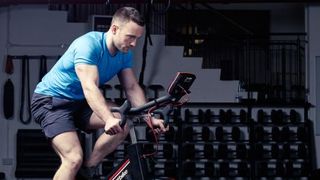Exercise Bike Workouts
13 workouts to help you get the most out of the exercise bike

We’d wager that the majority of a gym’s stationary bikes get used in one of two ways: either as the cardio kit used to warm up for a weights workout and then to warm down after, or for standalone sessions of simple, effortless pedalling until boredom sets in.
But these bikes can be highly effective training tools so long as you don’t just hop on and go through the motions. Cycle smarter with one of these varied sessions. Whether you’re looking to challenge yourself, improve endurance, burn body fat, enhance your road-racing speed when you get back to the great outdoors, or just fit in a workout and get back to your desk before the lunch bell rings, you’ll find something to suit below.
How to set the saddle
Although it can be tempting to just hop on and start pedalling, you should adjust the seat height so that it reaches hip level when you’re standing next to it. Too high and you’ll constantly overreach to complete each stroke, making your action inefficient. Too low will put pressure on your knee joints.
Stand next to the bike, then adjust the seat so that it’s the same height as your hip. Then sit on the saddle and make sure your leg is straight when your heel is on the pedal at the bottom of your pedal stroke. This position will ensure that there is a slight bend in your knee at the bottom of the stroke when you’re cycling properly.
The handlebar position, if adjustable, is down to individual preference – try them level with the seat, then adjust them over time to find your sweet spot. Finally, your seat should be far enough away from the handlebars that the front of your knee sits directly above the middle of the pedal.
Simple Exercise Bike Workout Ideas
Learn these basic workout templates from elite coach Nick Morgan and you’ll always an option when you’re wondering what to do when you step into your gym.
Conquer the hills

What? A steady, gradual increase of intensity to replicate a long hill climb.
Get the Coach Newsletter
Sign up for workout ideas, training advice, reviews of the latest gear and more.
Why? “Hills build leg strength. The harder you can pedal for longer, the faster you’ll be on both the hills and the flats,” says Morgan.
Climb the pyramid

What? Gradually increasing the intensity to a climax and then reducing it again.
Why? “Pyramids put the benefits of the hill programme into action. After working hard on the ascent, the slow reduction in difficulty means you can stay at a higher cadence to get more out of each level.”
Up the threshold

What? Training near your maximum aerobic capacity for as long as you can sustain it.
Why? “Normally 20 to 30 minutes long, this type of session creates a build-up of lactic acid that causes fatigue. Training outside your comfort zone is the most effective way of getting fitter and stronger.”
Exercise Bike Workouts By Time
Sometimes the most important factor in deciding what kind of exercise bike workout you’re going to do is not by your goal, but time. We enlisted Reynold Antwi, cycle instructor at boutique gym Another_Space, to suggest 15-minute, 30-minute and 45-minute workouts so you can fit a session into even the most squeezed of lunch breaks. Remember – even if you only opt for the 15-minute workout, it’s worth taking a minute or two to stretch afterwards to help avoid injury.
15-minute exercise bike workout
- Start with a 5min warm-up, going at a fast speed with low resistance.
- For the next 5min cycle quickly, alternating between sitting and standing every 30sec.
- For your final push, ramp up the resistance and cycle as quickly as you can for 1min.
- Finish with a 4min warm-down, slowing bringing down the resistance until it’s off.
30-minute exercise bike workout
This is a Tabata-style workout, so you work in blocks of 20sec all out effort and 10sec recovery.
- Start with a 5min warm-up, going at a fast speed with low resistance.
- Cycle for 20sec with medium resistance, then lower the resistance for 10sec. Repeat eight times, then recover for 1min by cycling with low resistance.
- Repeat step 2 three more times.
- Warm down for 5min cycling slowly, removing resistance gradually until it’s off.
45-minute exercise bike workout
For some extra upper-body work, have a pair of light dumbbells handy to use during this workout.
- Start with a 5min warm-up, going at a fast speed with low resistance.
- Get out of the saddle and cycle standing for 5min, at a medium speed and medium resistance.
- Switch to a light resistance and cycle as fast as you can for 2min, then sit down on the saddle, and maintain the same pace and resistance for 3min.
- Add a touch more resistance and repeat step 3.
- Cycling standing for 1min at a fast pace with high resistance.
- Move back to seated for 3min at a fast pace, with light resistance.
- Back to standing for 5min at a medium pace with high resistance.
- Sit down for 2min and cycle at a medium pace with light resistance. During this step, grab your dumbbells and perform dumbbell curls.
- Pick up the pace and cycle fast with light resistance for 5min.
- Slowly add resistance while maintaining your pace for 4min – you should be struggling to pedal by the end.
- Remove all resistance and warm down by slowing your pace over the course of 5min.
See related
- The Best Exercise Bikes Of 2021
- Wattbike Workouts To Power Up Your Fitness
- The Cyclist’s Home Workout
- Treadmill Workouts To Freshen Up Your Indoor Running
- Rowing Machine Workouts For Fat Loss, Plus Building Muscle, Speed And Endurance
The Exercise Bike Hour Challenge
The record for this – 54.526km – was set on 7th June 2015 from British cycling legend Sir Bradley Wiggins. While that is probably beyond you, 35km is a tough but achievable target on an exercise bike.
Build up to it by starting with a 20-minute ride at a high intensity, say 80% of your maximum heart rate (find out how to calculate your heart rate zones). With every session, keep pushing the distance you hold the intensity at by five minutes until you can hold it for 40 minutes. This will boost your lactate threshold, which is your body’s ability to use the acid produced by your muscles as fuel, meaning you can go harder for longer.
Once you’ve hit the 40-minute mark it’s time to attempt the full hour. To get the best time possible, aim for a negative split – that's where you complete the second half of the challenge faster than the first. In other words don't go out all guns blazing and burn out at the 30-minute mark.
Exercise Bike Workouts By Goal
Speed workout 1
If you want to use the stationary bike to get faster on the road, you need to focus on high cadence – the speed that you turn over the pedals. The other key aspect is improving your ability to push harder for longer, then recover quicker, to push on again.
Warm-up: 10min at low cadence and low resistance.
0-10min: Sprint for 6sec every minute on the minute.
11-20min: 60sec hard effort followed by 60sec easy effort. Keep top effort level around 9 RPE or 80-90% MHR.
Warm-down: 10min, with the final 5min at low cadence and low resistance.
Speed workout 2
If you’re more Mark “The Manx Missile” Cavendish than mountain dwelling Chris Froome, you need to use the stationary bike to get faster on the road. Focus on high cadence – the speed that you turn over the pedals – to generate explosive acceleration that’ll leave your fellow commuters at a standstill. The other focus needs to be power endurance so you can maintain a high tempo for long enough to make your burst of pace sustainable, then recover quickly so you can push on again. This workout from Tom Eastham, strength and nutrition coach based at W10 Performance in London will deliver on both fronts.
Start with a warm-up of 10 minutes at a low cadence and low resistance. For minutes 11-20 sprint for six seconds at the start of every minute. For minutes 21-30 alternate 60 seconds of hard effort with 60 seconds of easy effort, aiming to keep your top effort level around a nine out of ten for your rate of perceived exertion, or 80-90% of your maximum heart rate if you’re wearing a heart-rate monitor (a simple formula for your max heart rate is 226 minus your age for women and 220 minus your age for men). Finish with a ten minute warm-down, winding down to a gentle cadence and resistance to flush the lactic out of your leg muscles.
Fat-loss workout 1
Don’t just sit and pedal in slow motion for 45 minutes, thinking you’re on your way to a better body by training in the so-called “fat-loss zone”. To shift your spare tyre you need to train hard and fast with high-intensity sprints that’ll shock your body into giving up its fat stores.
Warm-up: 5min at low cadence and low resistance.
0-5min: High cadence, low resistance.
5-10min: Low cadence, high resistance.
10-14min: Tabata sprints: 20sec all-out effort, followed by 10sec recovery, a total of eight times.
Warm-down: 5min at low cadence and low resistance.
Fat-loss workout 2
After a ten-minute warm-up, do 20 seconds of flat-out pedalling, then rest for ten seconds. Repeat this eight times. The session will only last four minutes but it will push your metabolism into fat-burning overdrive.
Endurance workout
The most accurate way to improve endurance is to train according to your Maximum Heart Rate (MHR). Spending time in higher heart rate zones – those above 80% of your MHR – will drastically improve your aerobic energy system, which is where you derive endurance ability from. It does this by improving your ability to recover faster from bouts of harder, more intense activity.
Most stationary bikes are able to monitor your heart rate, either through metallic handles that measure your beats per minute or by wirelessly reading the heart rate monitor you’re wearing. If you don’t have this option, use the Rate of Perceived Exertion scale. This goes from 1 to 10, where 1 is extremely easy effort, 5 is moderate effort and 10 is all-out maximum effort.
Warm-up: 5min easy pace
0-5min: HR Zone 50-60% or 4-5/10 RPE
5-10min: HR Zone 60-70% or 6-7/10 RPE
10-15min: HR Zone 70-80% or 7-8/10 RPE
15-17min: HR Zone 80-90% or 8-9/10 RPE
17-25min: Let your HR drop to 60-70% then ramp it back up to 80-90%. Keep going until it goes over 90%. Then drop it back to 60-70% and repeat the process for a total of 10min.
Warm-down: 5min at easy pace.
Active recovery session
The stationary bike is ideal for aiding recovery a day or two after a tough legs session. Longer, slower sessions help to improve aerobic capacity and pump blood and nutrients into your leg muscles while flushing out all the waste products caused by intense exercise (we’re looking at you, leg day).
Warm up for five minutes at an easy pace, then hop off the bike to do ten to 15 minutes of mobility work. Get back on the bike, with Netflix on your iPad ready to go, and start pedalling at a low effort – around 40-50% of your maximum heart rate or a 5/6 on the RPE scale (that’s rate of perceived exertion). Aim for 45 minutes of consistent and controlled pedalling to keep your legs muscles moving and reduce your muscular aches and pains.

Joe Warner is a highly experienced journalist and editor who began working in fitness media in 2008. He has featured on the cover of Men’s Fitness UK twice and has co-authored Amazon best-sellers including 12-Week Body Plan. He was the editor of Men’s Fitness UK magazine between 2016 and 2019, when that title shared a website with Coach.
